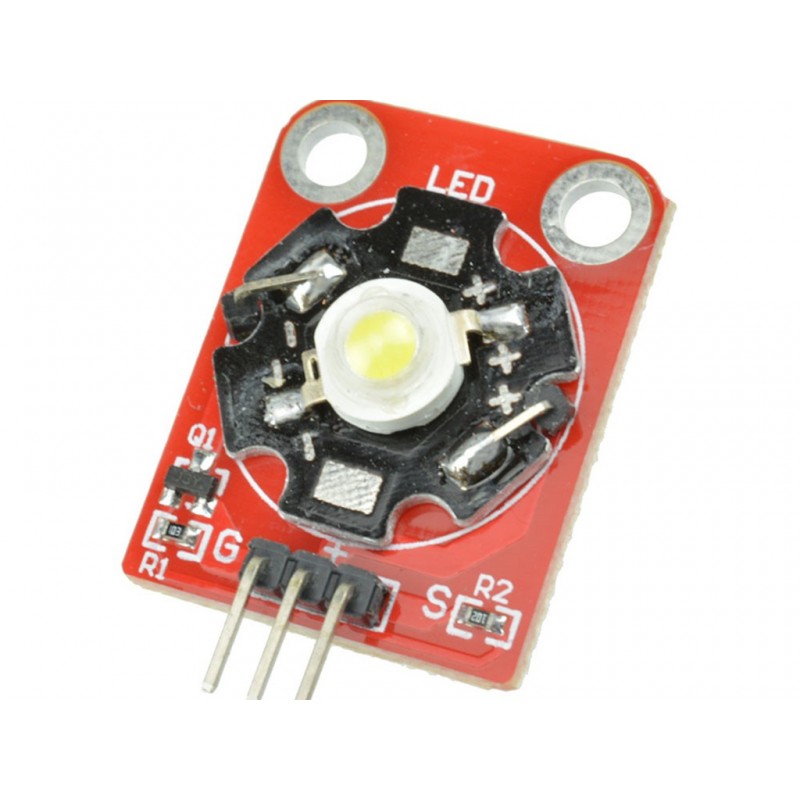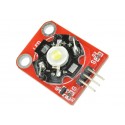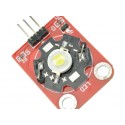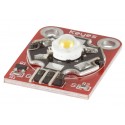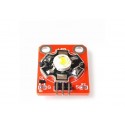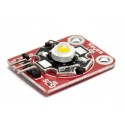3 Watt Led Module
Rs. 68.00 Rs. 82.00
- Product Code: SEN-LED
- Availability: In Stock
- Price in reward points: 1
- For Bulk Order
 9962060070
9962060070
| SPECIFICATIONS: | |
| Color temperature | Warm White 3000-3200K / white 6000-6500K |
| Forward current | 700 ma |
| Luminous flux | White 180-200LM (lumens) |
| Forward voltage | 3.3 - 3.6 V |
| Reverse voltage | 5 Volts |
| Power | 3 Watts |
| Viewing angle | 180° |
| Working temperature | -20° to 60° |
| Storage temperature | 20° to 60° |
OVERVIEW:
-Highest flux per LED family in the world
-Very long operating life (up to 100k hours)
-Available in Red, Yellow, Green, Blue, White
-Lambertian radiation pattern
-More energy efficient than incandescent and most halogen lamps
-Low voltage DC operated
-Cool beam, safe to the touch
-Fully dimmable
-No UV
-Superior ESD protection
-lower Rth 3W Blue LED
-RoHS compliant — Lead-free
-Instant light (less than 100ns )
PACKAGE INCLUDES:
1 PCS x 3 Watt Led Module
/*SOURCE CODE TAKEN FROM BELOW LINK
https://arduinoinfo.mywikis.net/wiki/SimpleStrobe
YourDuinoStarter Example: Controllable Time Strobe LED V3 "SpinnerStrobe"
- WHAT IT DOES: Flashes an LED with variable timing set by a potentiometer
- Can "stop" motion of rotating wheels, fans etc.
- Works best with a High Output LED like this:
http://yourduino.com/sunshop2/index.php?l=product_detail&p=458
- Can tell you the "RPM" of a device with 1, 2 or 3 "legs"
- INFO: See https://arduinoinfo.mywikis.net/wiki/SimpleStrobe
- SEE the comments after "//" on each line below
- CONNECTIONS:
- LED: Pin 13
- Potentiometer: Pin A2
- V1.06 05/31/2015
Questions: terry@yourduino.com */
/*-----( Declare Pin Numbers )-----*/
#define potentiometerPin 2 // Pot connected to ANALOG Pin 2 will control strobe speed.
#define ledPin 13 // Same as the small built-in LED, also use for separate bright LED
#define otherLedPin 12 // Optional for more LEDs, not-so-bright LEDs
/*-----( Declare Constant Values )-----*/
// Set the minimum delay between flashes in milliseconds (thousandths of a second)
#define minDelay 1 // 1/1000 of a second
#define maxDelay 500 //SO: That's 200/1000 right? 1/5 of a second. 5 flashes per second.
// How long should the each flash be?
#define onTime 500 //SO: 500/1000000 hmm.. reduce fraction: .5/1000 1/2 of 1/1000 of a second
/*-----( Declare Variables )-----*/
int potPosition ; // Value from analogRead of the pot. Values from 0..1023
int strobeDelay ; // How long between flashes? Changed by Pot position
void setup() /****** SETUP: RUNS ONCE AT THE BEGINNING ******/
{
Serial.begin(115200); // Start the serial port (Watch on serial monitor)
pinMode(ledPin, OUTPUT); // Set up ledPins as an output.
pinMode(otherLedPin, OUTPUT);
Serial.println("START Strobe for Fidgit Spinner etc.");
}//--(end setup )---
void loop() /****** LOOP: RUNS CONSTANTLY ******/
{
potPosition = analogRead(potentiometerPin); // Read the pot position
// convert the 0 to 1023 range we get from analogRead, into our strobe delay range of 1 to 200
strobeDelay = map(potPosition, 0, 1023, maxDelay, minDelay); // Clockwise is faster??
Serial.print("StrobeDelay(Milliseconds) = ");
Serial.print(strobeDelay);
Serial.print(" Revolutions per second) = ");
Serial.print(1000 / strobeDelay);
Serial.print(" Revolutions per minute) = ");
Serial.println(60 * (1000 / strobeDelay));
/*---( Blink the LED ON and OFF )-----*/
for (int i = 0; i < 10; i++)
{
digitalWrite(ledPin, HIGH); // Switch the ledPin to HIGH, turn it on!
digitalWrite(otherLedPin, HIGH); // Switch the ledPin to HIGH, turn it on!
delayMicroseconds(onTime); // Delay while on, for onTime.
digitalWrite(ledPin, LOW); // Switch the ledPin to LOW, turn if off!
digitalWrite(otherLedPin, LOW); // Switch the ledPin to LOW, turn if off!
delay(strobeDelay); // Delay while off, for strobeDelay
}
}//--(end main loop )---
//*********( THE END )***********
15 days

